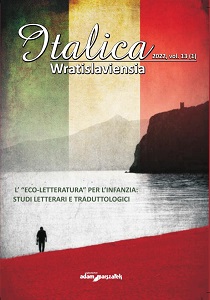Letteratura per l’infanzia e l’adolescenza dal/del Nord-Est Italia. Una analisidegli eco-assi da Salgari a Scarpa (1901–2021)
Children’s and Young Adult Literature from Northeast Italy: An Eco-Axes Analysis from Salgari to Scarpa, 1901–2021
Author(s): Pietro MazzarisiSubject(s): Gender Studies, Recent History (1900 till today), Comparative Study of Literature, Theory of Literature, Italian literature, Pedagogy, Sociology of Literature
Published by: Wydawnictwo Adam Marszałek
Keywords: children’s literature; young adult literature; Northeast Italy; ecopedagogy; ecofeminism; NatCul Matrix; eco-axes analysis;
Summary/Abstract: Over the last hundred years and since the Second World War at the speed of the Great Acceleration, the Anthropocene has been intensively impacting the Northeast of Italy and, as a result, redrawn the Triangolo Industriale, shifting it towards the East, whereby its two prior western cities – Turin and Genoa – have been replaced with the production hubs scattered along the Via Emilia and Veneto. The coastal region has seen the foundation and robust growth of Porto Marghera with its freight, metallurgy, chemical, mechanical, shipbuilding, oil and electricity sectors; the Veneto plain has witnessed an expansion of SMEs; and Emilia has become home to multinational corporations. While not subject to industrialisation, the mountains of the Triveneto have not been exempt from a thorough modernisation on the scale unparalleled in the Italian Alps. Considering these changes, this paper surveys a range of literary works from Salgari to Scarpa (via Albertazzi, Zavattini, Buzzati, Guerra, D’Arzo, Pratt, Malerba, Altan, Nanetti, Benni, Rigoni Stern, Molesini, Costa, Corona, Carminati, Sgardoli, Tamaro, Tessaro and Ervas) in order to establish what role is given to environmental issues by the authors of children’s literature in the Northeast and whether (dis)continuities emerge in the body of their writings in this respect. The paper also investigates which authors present an active sensitivity useful for fostering an eco-consciousness and in what ways they do so. The methodology combines an array of critical tools developed in eco-pedagogical criticism, ecofeminism and the NatCul Matrix, geared to answering a series of questions: (1) Is basic environmental literacy offered? (2) Is a critical reflection on human primacy and environmental (in)sustainability implicit, explicit or absent? (3) How are humanity and nature related in children’s literature? (4) How is eco-justice approached? (5) What attitudinal role does the narrative assign to nature?
Journal: Italica Wratislaviensia
- Issue Year: 13/2022
- Issue No: 1
- Page Range: 97-137
- Page Count: 41
- Language: Italian

